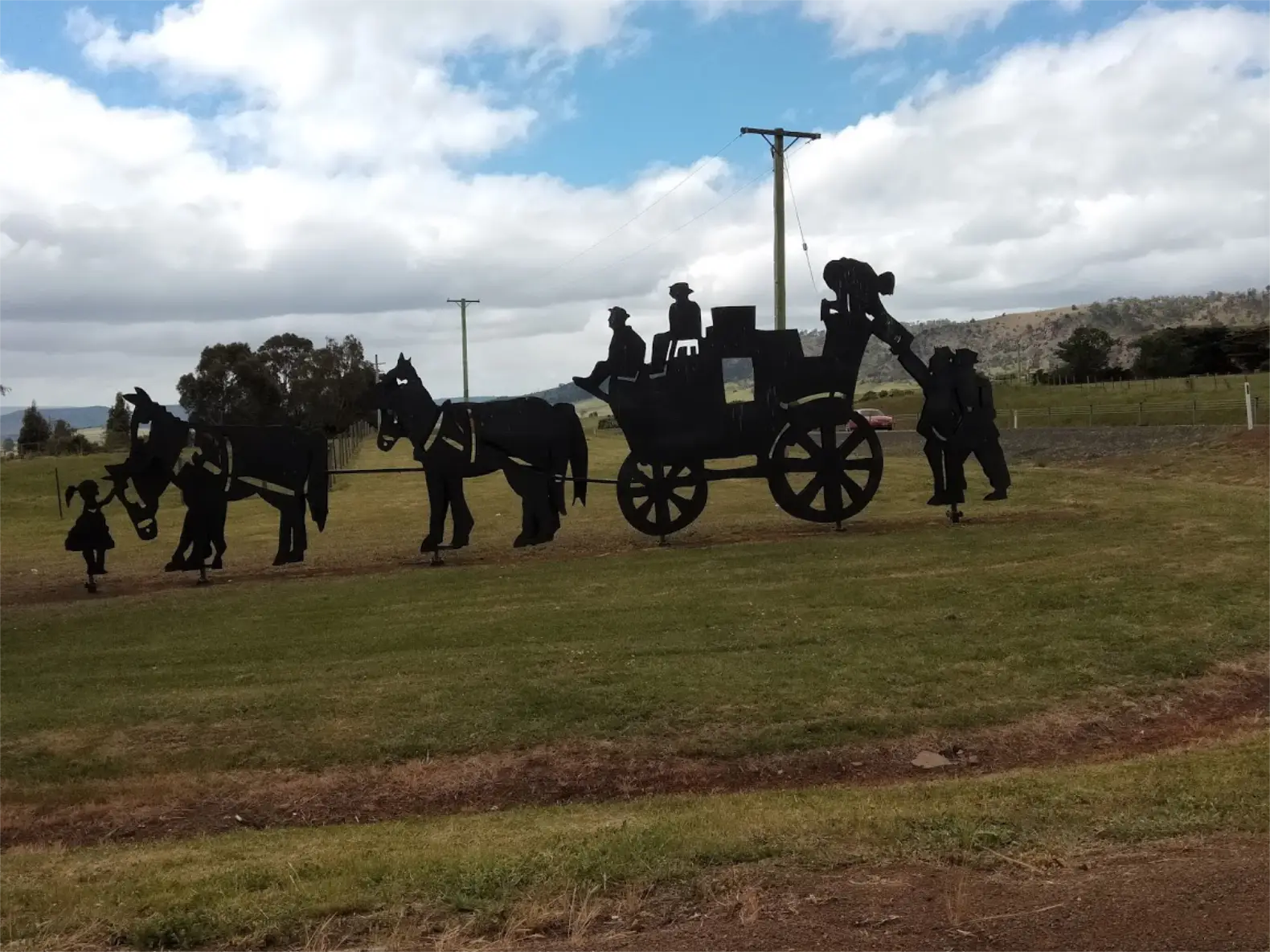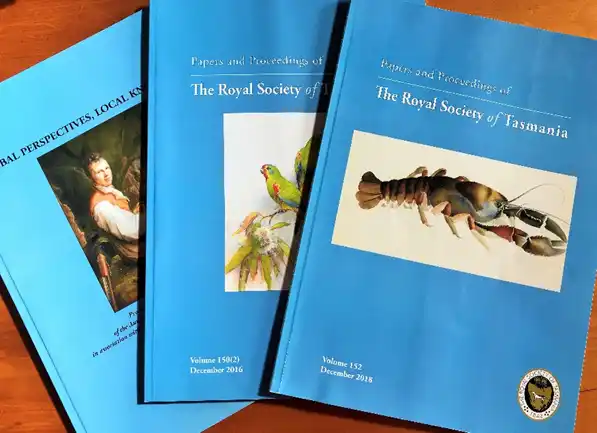
RST Apology to Tasmanian Aboriginal people 2021.

RST Apology to Tasmanian Aboriginal people 2021.

Since 1849, The Royal Society of Tasmania has published annual volumes of refereed scholarly papers about Tasmania in the Papers and Proceedings of the Royal Society of Tasmania and, from time to time, monographs and special, generally thematic, issues of the journal. Its authors are from institutions worldwide and its subscribers include learned societies, research institutions and universities all over the world. Volumes have been published annually since 1851.
Papers and Proceedings of the Royal Society of Tasmania is Open Access. Soon after the volume is published authors are issued with an electronic version of their paper and encouraged to distribute it through their networks. Reproduction of synopses in abstracting journals is authorised. All papers are available on-line from the UTAS open access site. Journals can be purchased in hard copy via the RST website or from the RST office with back volumes also available on request. RST Members can elect to receive the Papers and Proceedings via their annual subscription with a hard copy posted at the time of publication. Normally one volume is published annually, depending on the number of accepted papers in a given year.
Papers and Proceedings of the Royal Society of Tasmania publishes research with a particular, but not exclusive, focus on Tasmanian and Antarctic natural science and history. Papers in the arts, social sciences or other disciplines with a focus or association on these same geographic areas are also encouraged. Papers are accepted from researchers worldwide providing the topic is of specific interest to the Tasmanian community.
Papers should embody the results of a significant piece of original work or offer an original synthesis or review. Submission implies that the contents are original and have not been published previously in any form, and that no similar manuscript will be submitted elsewhere.
Manuscripts submitted to Papers and Proceedings of the Royal Society of Tasmania are peer-reviewed. Further details on the submission and peer-review processes are provided in the Instructions to Authors below.
To be considered for publication, manuscripts must be of primary interest or relevance to Tasmania and the wider Australian community and be easily understood by a general audience. A printable PDF of this page can be downloaded from this link.
Publication priorities are:
Manuscripts must contain new and previously unpublished content and be of interest to a wide readership. All papers are subject to peer review.
Full Paper: Typically, 2,000 to 6,000 words maximum length including references. Associated plates, figures, tables and appendices can be submitted. Longer papers will be reduced by the Editor.
Short Note: Typically, up to 2,000 words including references and can include one to two associated plates, figures or tables.
Review Paper: Typically, 2,000 to 6,000 words maximum length including both narrative and systematic reviews and meta-analyses. Can include two to four plates or figures. Usually on a broad subject theme of relevance and wide interest to the Tasmanian community.
Transcript: Published by invitation from a RST presentation. In consultation with the presenter, transcripts will undergo editing and may not necessarily include the full presentation. Any opinions expressed in transcript papers are those of the authors and should not be intended to malign any individual, group, company, or entity. Information of a personal nature may not necessarily be published especially if it invokes a right-to-reply.
Papers should be well written with a minimum of jargon, presented in clear, concise English with spelling according to the Macquarie Dictionary. The Editor reserves the right to adjust or reduce the text for clarity, conformity to style, and publication standards.
Structure
Order of contents
Citation format
Examples of reference format for papers, journals, books, etc.: (order author alphabetically oldest date first)
Artyukhin, YB & Burkanov, VN (2000). Incidental mortality of seabirds in the drift net salmon fishery by Japanese vessels in the Russian Exclusive Economic Zone, 1993–1997. In Kondratyev, AY, Litvineko, NM & Kaiser, GW (eds). Seabirds of the Russian Far East. Ottawa, Canadian Wildlife Service Special Publication: 105–116.
ABARES (2021). Broad Land Use in Tasmania. https://www.agriculture.gov.au/sites/default/files/sitecollectionimages/abares/land-use-tas-state-large.png (accessed 21 July 2021).
Bingham, M (1998). The distribution, abundance and population trends of gentoo, rockhopper and king penguins in the Falkland Islands. Oryx 32: 223–232.
Charleton, KJ (2002). Variation in sooty shearwater burrow entrance density, burrow use and chick emergence: Science and traditional environmental knowledge approaches. Unpublished MSc Thesis, University of Otago, Dunedin.
Chiswell, SM & Rickard, GJ (2006). Comparison of model and observational ocean circulation climatology’s for the New Zealand region. Journal of Geophysical Research 111: C10011, https://doi.org/10.1029/2006JC003489.
Davison, AC & Hinkley, DV (1997). Bootstrap methods and their application. Cambridge University Press, Cambridge: 592 pp.
Hawke, DJ, Smith, S & Newman, J (2005). Using isotope analysis to identify incorporation of marine nutrients in terrestrial birds at Snares Islands. Notornis 52: 108–111.
IUCN (2001). IUCN Red List of Threatened Species 2001 Categories & Criteria (version 3.1), www.iucnredlist.org (accessed 22 January 2023).
Kellermann, J (2005). New combinations for two species of Spyridium (Rhamnaceae: Pomaderreae) from the Grampians, Victoria. Muelleria 22: 97–104.
MacKenzie, DI & Fletcher, D (2005). Characterisation of seabird captures in NZ fisheries. Report to Ministry of Fisheries for Project ENV2004-04. April 2006. Unpublished report to the Ministry of Fisheries, Wellington: 99 pp.
Marchant, S & Higgins, PJ (eds) (1993). Handbook of Australian, New Zealand and Antarctic Birds. Volume 2: Raptors to Lapwings. Oxford University Press, Melbourne, Australia: 1,048 pp.
Number consecutively in the order of their first reference in the text.
Tables
Figures and Plates
Material presented as Appendices (labelled 1, 2, 3, etc.) are accepted at the Honorary Editor’s discretion, and may be printed in a smaller type than the rest of the paper.
The Botanical, Zoological and Stratigraphic Codes of Nomenclature should be fully observed. Use of SI units of measurement is strongly preferred where consistent with the means of measurement.
Australian Government Style Guide: https://www.stylemanual.gov.au/
Verbatim quotations of text must be acknowledged, and the source given (with the relevant page number/s). Authors must specifically acknowledge the source of illustrations that have been previously published elsewhere and are not their property and must obtain permission for publication of text or illustrations covered by copyright.
Permission to use material previously published by The Royal Society of Tasmania can be obtained upon application to the Council via the Honorary Editor.
Please contact the Honorary Editor at [email protected] with any queries or to submit papers. Please submit your paper electronically as a Word doc to The Honorary Editor at [email protected]
All figures, plates and tables must be submitted separately to the Word document as TIF, JPG, PDF or EPDS files. If the document exceeds the email size limits, please notify the Editor to share using, e.g., Dropbox. Alternatively, send a USB thumb drive to The Honorary Editor, The Royal Society of Tasmania, PO Box 11, Franklin TAS 7113, Australia. Please include your email address and the name of the person to contact for editorial queries, proofs etc.
Manuscripts can be submitted at any time. The journal is published annually so depending on the number of submissions received, your paper may not make the current year’s volume.
All submissions undergo preliminary assessment by the Editor, who may reject a paper if it is outside the journal’s scope or of insufficient quality. Accepted submissions are sent to independent assessors for peer reviewer. The Editor will then take into consideration the advice of reviewers before deciding to recommend accept, amend or to reject the paper. That decision will be final. If the paper is not accepted, a copy will be retained by the Society. The Society retains copyright of accepted papers.
Authors are issued with an electronic version of their paper and encouraged to distribute it openly through all networks. Reproduction of synopses in abstracting journals is authorised. All papers are available on-line soon after the Volume is published from the UTAS open access site.
For Institutional subscriptions please contact the Honorary Editor via our Contact Us form.
Prices for back editions of Papers & Proceedings range from $10 to $40 per volume. Members of the Royal Society are eligible for a 10% discount. To learn more regarding back editions, please contact the Honorary Editor.
Single papers from all volumes are freely available at the University of Tasmania portal


The Royal Society of Tasmania acknowledges, with deep respect, the traditional owners of this land, and the ongoing custodianship of the Aboriginal people of Tasmania. The Society pays respect to Elders past, present and emerging. We acknowledge that Tasmanian Aboriginal Peoples have survived severe and unjust impacts resulting from invasion and dispossession of their Country. As an institution dedicated to the advancement of knowledge, the Royal Society of Tasmania recognises Aboriginal cultural knowledge and practices and seeks to respect and honour these traditions and the deep understanding they represent.

On 15 February 2021, the Royal Society of Tasmania offered a formal Apology to the Tasmanian Aboriginal people.